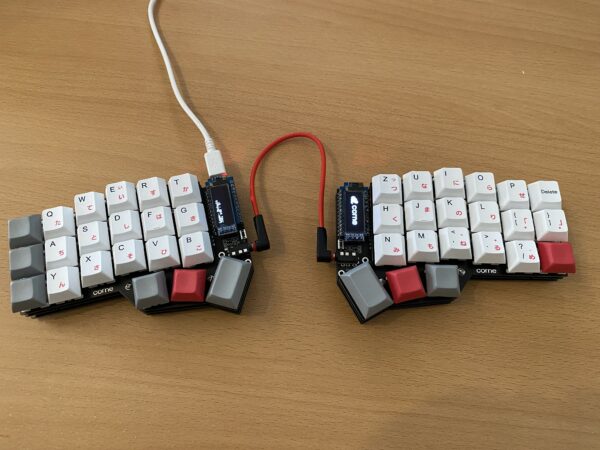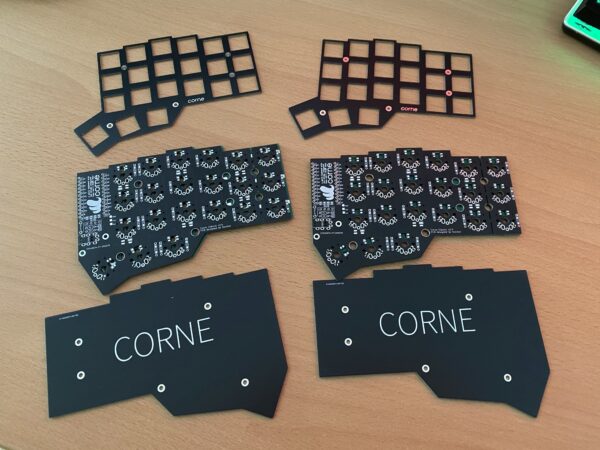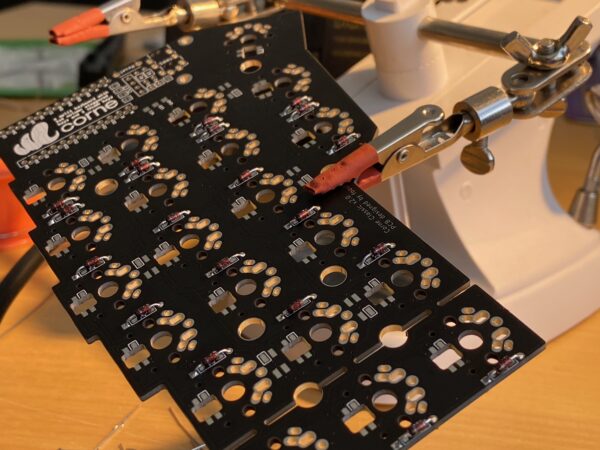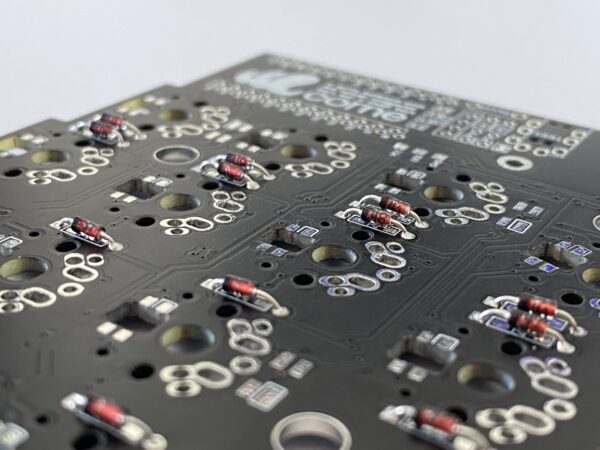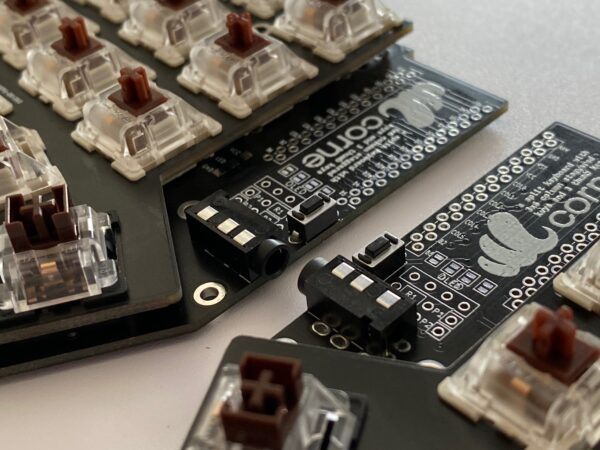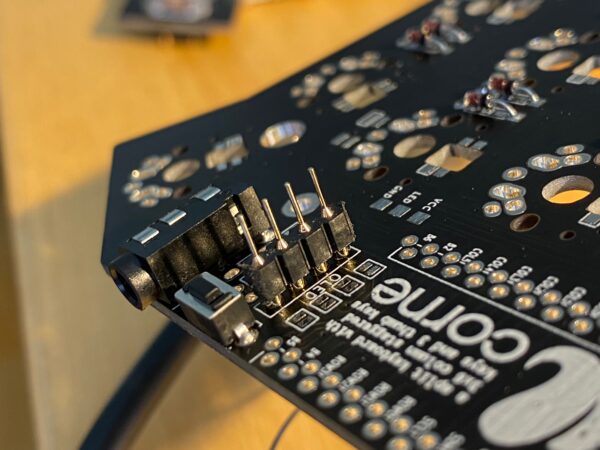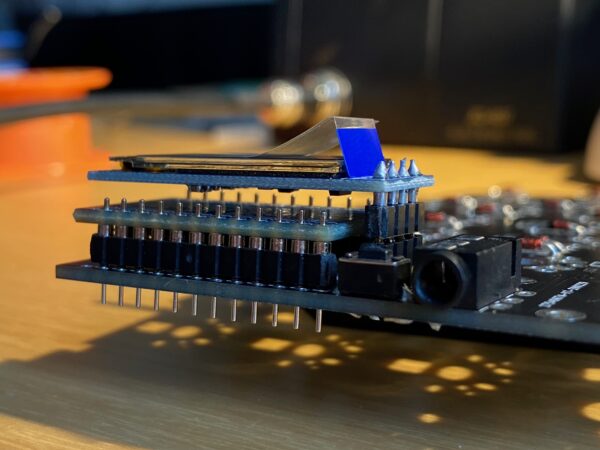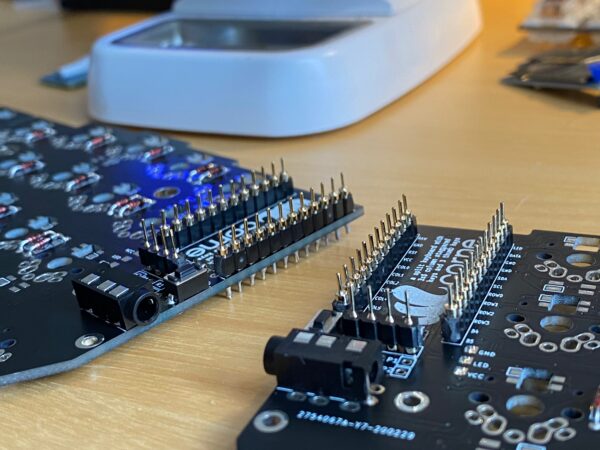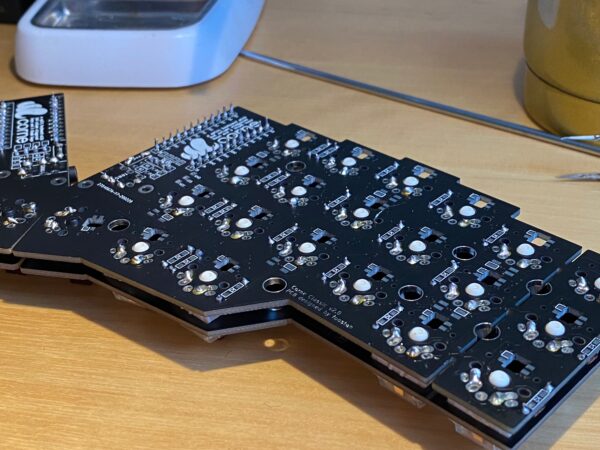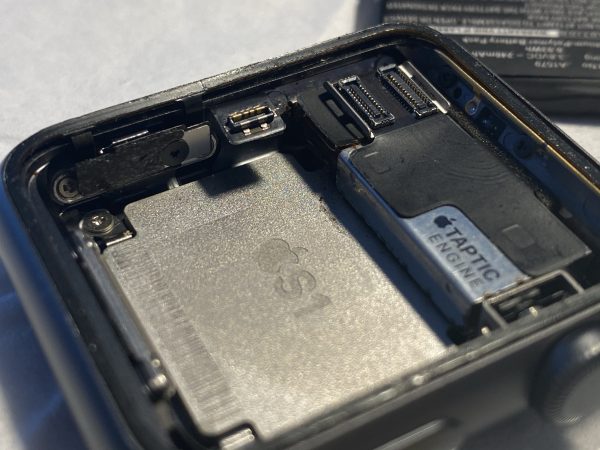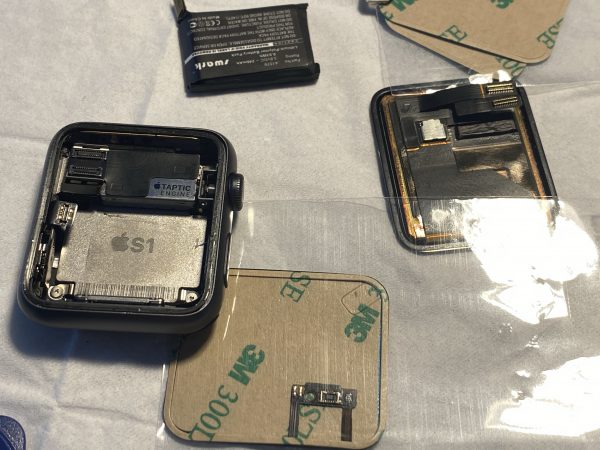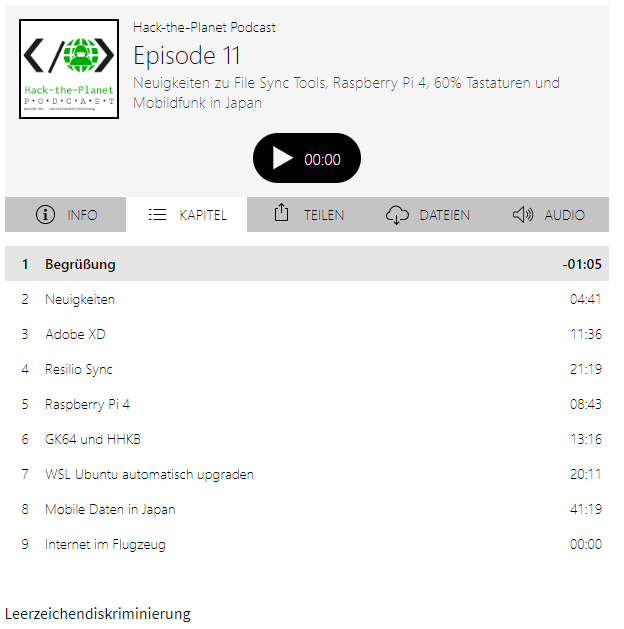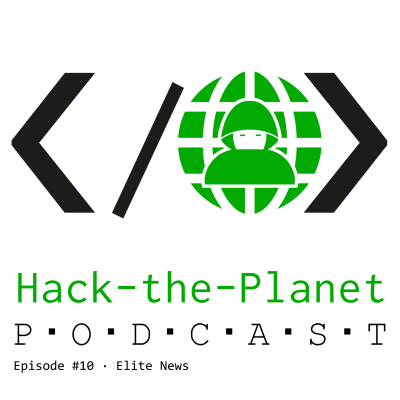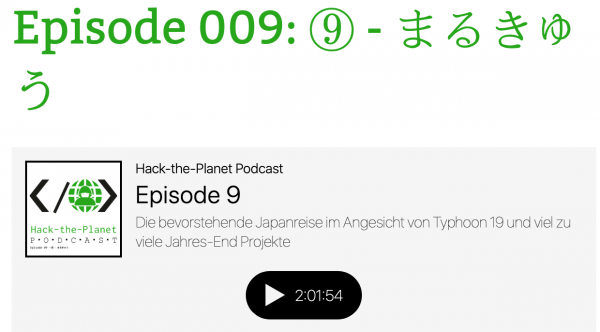In dieser Folge des „Hack the Planet“ Podcasts diskutieren Daniel und Andreas über Smartmeter, Code mit LLMs, Grafiken (ohne KI), einen USB-Kabeltester, eine teure Gamer-Tastatur, selbstprogrammierte Features und den Xbox Elite Controller. Andreas berichtet über seine Erfahrungen mit Smartmetern und den Herausforderungen, die damit einhergehen, wie z.B. der Kosten und der Umstellung auf neue Technologien. Sie sprechen auch über Photovoltaikanlagen, Batteriespeicher und die Regulierungen, die es erforderlich machen, Smartmeter zu installieren. Außerdem geht es über die Herausforderungen und den Spaß, den sie beim Programmieren mit LLMs hatten, sowie über ihre Erlebnisse mit neuen technologischen Gadgets.
Hack-the-Planet Podcast Episode 35: Aufruhr generiert!
In der 35. Folge des Hack-the-Planet-Podcasts diskutieren Daniel und Andreas eine Vielzahl von Themen rund um Technik, 3D-Druck, persönliche Projekte und Community-Veranstaltungen. Sie beginnen mit einem Rückblick auf die lange Pause seit der letzten Folge und teilen ihre Erfahrungen mit technischen Problemen und Updates an ihren Computern und Software.
Ein zentrales Thema ist der 3D-Druck, wobei Daniel seine Erfahrungen mit verschiedenen 3D-Druckern und Materialien wie PLA und PETG teilt. Er beschreibt die Herausforderungen und Lernkurven beim 3D-Druck sowie die Nachbearbeitung der Drucke. Andreas berichtet von seinen Projekten, darunter der Bau einer kompletten Trooper-Uniform aus Star Wars und eines lebensgroßen B1-Battle-Droiden. Andreas berichtet von Science-Fiction-Treffen und Cosplay-Veranstaltungen, insbesondere dem jährlichen Treffen in Speyer, und beschreibt die Technikmuseen in Speyer und Sinsheim.
Daniel und Andreas diskutieren zudem verschiedene technische Gadgets, einschließlich der Nutzung von ESP32 für Chat-Anwendungen im Flugzeug, und teilen ihre Erfahrungen mit der Sicherheit und Lagerung von Lithium-Polymer-Batterien.
Ein weiteres Thema ist die Einrichtung eines eigenen Minecraft-Servers für die Familie und die Herausforderungen bei der Nutzung von Xbox und anderen Konsolen für Multiplayer-Spiele.
Hack-the-Planet Podcast Episode 34: unsere letzte VR Hoffnung
Shownotes:
- Freiwillige Feuerwehr – https://de.wikipedia.org/wiki/Freiwillige_Feuerwehr
- Tetra Digitalfunk bei der Feuerwehr – https://www.feuerwehrmagazin.de/thema/digitalfunk-feuerwehr
- Zoom CEO: Remote work does not work https://www.theverge.com/2023/8/7/23823464/zoom-remote-work-return-to-office-hybrid
- Pfusch beim Tiefbau: Immer mehr Gemeinden streiten mit Deutsche Glasfaser – Golem.de
- Open Access Network – Wikipedia
- OpenCore Legacy – https://dortania.github.io/OpenCore-Legacy-Patcher/
- ChatGPT export to Markdown – https://github.com/pionxzh/chatgpt-exporter
- LLM Farm – https://llmfarm.site/
- Anycubic 3D Drucker – https://de.anycubic.com/collections/schneller-3d-drucker-materialien/products/kobra-2-neo
- OnShape 3D Software – Onshape | Product Development Platform
- 3D Modelle für 3D Druck – Thingiverse – Digital Designs for Physical Objects
- Persistence of Vision Raytracer – http://www.povray.org/
- Blender – https://www.blender.org/
- Govee – Govee – Ihr Leben wird intelligenter – EU-GOVEE
- Govee auf Google Maps – https://maps.app.goo.gl/SoUovsYyTPSxsFnj9
- Steamdeck OLED – Introducing Steam Deck OLED
- ROG Ally – https://rog.asus.com/de/gaming-handhelds/rog-ally/rog-ally-2023/
- Starfield – https://bethesda.net/de/game/starfield
- Cyberpunk Phantom Liberty – https://www.cyberpunk.net/us/de/phantom-liberty
- Persona 5 – https://de.wikipedia.org/wiki/Persona_5
- Meta Quest 3 – https://www.meta.com/de/quest/quest-3/
- Motion Sickness – https://de.wikipedia.org/wiki/Reisekrankheit
- Red Matter – https://redmattergame.com/
- Red Matter 2 – https://redmatter2.com/
Hack-the-Planet Podcast Episode 33: Shit in, Shit out!
Nach über einem Jahr haben wir uns wieder zusammengefunden und aufgezeichnet. Aber hört selbst:
Links:
- Wielandstecker vs. Schuko https://www.homeandsmart.de/balkonkraftwerk-wieland-steckdose-schuko-steckdose#:~:text=Der%20Wieland%20Stecker%20ist%20aus,die%20%C3%9Cberhitzung%20und%20Brandgefahr%20minimiert.
- Trunking und Glas Router für wenig Geld – https://mikrotik.com/
- Edogawa Ryukan Waterworks – https://www.ktr.mlit.go.jp/edogawa/edogawa_index042.html
- Château Picard: https://startrekwines.com
- LuckyV – https://www.luckyv.de
- Ariane Manga Band 1 Release Party Stream Aufzeichnung – https://www.youtube.com/watch?v=Vlc_JfYNETk
- Ariane Manga Band 1 – https://www.fischerverlage.de/buch/pandorya-ariane-9783733550271
- Ariane Manga Band 2 – https://www.fischerverlage.de/buch/pandorya-ariane-hard-reset-daemonen-der-vergangenheit-9783733550301
- GL.Inet Reiserouter – https://www.gl-inet.com/
- Pico4 VR Headset – https://www.picoxr.com/de
- Pico4 Specs: https://www.picoxr.com/de/products/pico4/specs
- PC-VR mit VirtualDesktop – https://www.vrdesktop.net
- Spiele gespielt und gestreamt – https://youtube.com/@bietiekay
- Sunshine – https://app.lizardbyte.dev/
- Moonlight – https://moonlight-stream.org/
- VirtualHere USB – https://www.virtualhere.com
- Obsidian – https://obsidian.md/
- EduSec – https://aheil.de/edusec/
- ChatGPT – https://en.wikipedia.org/wiki/ChatGPT
Hack-the-Planet Podcast Episode 30: Waren des täglichen Bedarfs
- Obsidian – https://obsidian.md/
- Obsidian Tasks Plugin – https://github.com/schemar/obsidian-tasks
- AutoHotkey – https://www.autohotkey.com/
- Nerd – https://www.urbandictionary.com/define.php?term=Nerd
- Unity Lights Watchface – https://appleinsider.com/articles/22/01/26/apple-watch-gets-new-unity-lights-watch-face
- Raytracing Ziffernblatt – https://www.mactechnews.de/news/article/Unity-Lights-Was-es-mit-dem-Raytracing-beim-neuen-Zifferblatt-der-Apple-Watch-auf-sich-hat-179398.html
- Technology Connections / Connextras – https://youtu.be/NeopkvAP-ag
- Apple Watch Complications – https://developer.apple.com/design/human-interface-guidelines/watchos/overview/complications/
- PortaPow – https://portablepowersupplies.co.uk/
- Juice Jacking – https://en.wikipedia.org/wiki/Juice_jacking
- USB Power Monitor – https://portablepowersupplies.co.uk/product/dual-usb-power-monitor
- USB Kondom – https://www.techbook.de/mobile/usb-kondom
- USB-C Power Monitor Kabel – https://de.aliexpress.com/item/1005002951923334.html
- GaN Netzteil – https://www.thefastcode.com/de-eur/article/what-is-a-gan-charger-and-why-will-you-want-one
- USB Type-C® Cable and Connector Specification Revision 2.1 – https://usb.org/document-library/usb-type-cr-cable-and-connector-specification-revision-21
- USB-C PD 2.1 – https://en.wikipedia.org/wiki/USB-C
- Assistive Touch – https://support.apple.com/en-sg/HT212760
- Keyboard für iPad PRO – https://www.schrankmonster.de/2021/07/24/a-keyboard-and-touchpad-for-the-ipad-pro/
- Jilles auf Twitter – https://twitter.com/jilles_com
- Sticker Operation Center – https://stickeroperation.center/2020/10/26/c3-sticker-exchange/
- Keyboard – https://stickeroperation.center/2020/12/14/update-rc3-sticker-exchange
- Click Clack Hack – https://www.nerdbude.com/podcast/ Nerd – Dr. Seuss – 1950 im Buch “If I Ran the Zoo.”
Hack-the-Planet Podcast Episode 29: Katzenfutter Automaten
- VB Audio Virtual Cable – https://vb-audio.com/Cable/
- VB Audio Potato – https://vb-audio.com/Voicemeeter/potato.htm
- Rogue Amoeba Audio Software – https://rogueamoeba.com/
- Obsidian.md – https://obsidian.md/
- Medizinische Informatik Bachelor Hochschule Heilbronn – https://www.hs-heilbronn.de/mib
- Theme Neon 80 https://forum.obsidian.md/t/80s-neon-theme/63
- IMF Workflow https://forum.obsidian.md/t/example-workflows-in-obsidian/1093
- Windows PathCopy – https://pathcopycopy.github.io/
- Diskordianismus – Pentabarf Regel 2 – https://de.wikipedia.org/wiki/Diskordianismus
- Katzenfutter Automat – https://www.surepetcare.com/en-us/pet-feeder/microchip-pet-feeder
- GitLab – https://about.gitlab.com/
- GitHub – https://github.com/
- OhMyGit – https://ohmygit.org/
- GoGitService Gogs – https://gogs.io/
- Build your own Octocat – https://myoctocat.com/
- GitKraken – https://www.gitkraken.com/
- GitAhead – https://gitahead.github.io/gitahead.com/
- NVIDIA Geforce Now – https://www.nvidia.com/en-us/geforce-now/
- Google Stadia – https://stadia.google.com/home
- Shadow – https://shadow.tech/de/
- Streaming Plattformen – Übersicht – http://www.gaming-magazin.de/cloud-gaming-anbieter/
- Xbox All Access – https://www.xbox.com/de-DE/xbox-all-access Google Stadia Controller – https://store.google.com/product/stadia_controller?hl=de
Hack-the-Planet Podcast Episode 28: Duplikate Schluckauf
- EOS M200 – https://www.canon.de/cameras/eos-m200/
- USB-Netzwerk-Speicher-Box – https://www.wut.de/e-53763-ww-dade-000.php
- Czkawka Duplikatsuche – https://github.com/qarmin/czkawka
- Polyglot Files – https://github.com/Polydet/polyglot-database
- Polyglot Files – https://github.com/corkami
- TCPA – https://en.wikipedia.org/wiki/Telephone_Consumer_Protection_Act_of_1991
- 36c3 Klimafreundliche Software – https://fahrplan.events.ccc.de/congress/2019/Fahrplan/events/10852.html
- Nucbox – https://gmktec.com/products/nucbox-most-powerful-palm-sized-4k-mini-pc-1
- YouTube Subtitles automatisch – https://www.dvdvideosoft.com/online-youtube-subtitles-download
- YouTube-DL – https://github.com/yt-dlp/yt-dlp
- Blinkenlights – http://blinkenlights.net/
- Window Tetris an der Hochschule – VL Embedded Systems https://www.youtube.com/watch?v=XArYYggf_J8
- Projekt Blinkelights https://en.wikipedia.org/wiki/Project_Blinkenlights
- Obsidian.md – https://obsidian.md/
- Obsidian Example Workflows – https://forum.obsidian.md/t/example-workflows-in-obsidian/1093
- Visual Studio Code – https://code.visualstudio.com/
- SSH und Ansible: https://aheil.de/blog/ansible_login_via_ssh
Hack-the-Planet Podcast: Episode 27 – Lucky We
Lucky We
- Twitter Muted Keywords – https://gist.github.com/IanColdwater/88b3341a7c4c0cf71c73ac56f9bd36ec
- Megablock – https://megablock.xyz/
- Sammlung Quellcode von vergangenen Games – https://github.com/videogamepreservation –
- MIcrosoft Surface Pro unterstützt Windows 11 nicht – https://support.microsoft.com/en-us/windows/ways-to-install-windows-11-e0edbbfb-cfc5-4011-868b-2ce77ac7c70e
- Corne Keyboards selber bauen – erste Erfahrungen – https://www.schrankmonster.de/2021/05/01/building-a-corne-split-keyboard/ https://www.nerdbude.com/podcast/index.html
- Vault of the Atomic Age – https://thevaultoftheatomicspaceage.tumblr.com/
- LuckyV – https://luckyv.de/
- xPandorya Visage Horrorspiel Stream – https://www.youtube.com/playlist?list=PLNlTppojtw-smn4ZjsPHqDmqAD1kcnwfJ
- Streamingübersicht LuckyV Streamer – https://luckyv-streamer.frozenpenguin.media/
- xPandorya Streams – https://www.twitch.tv/xpandorya/videos
- Grand Theft Auto V (GTA V) – https://www.rockstargames.com/V
- AltV – https://altv.mp
- Apps von Daniel für Streamer: https://github.com/bietiekay/LuckyVPlayerCounter und https://github.com/bietiekay/Los-Santos-Transit-Bus-Streamer-Display
- Eigener RP Character von Daniel: “Henry McCarty” – https://www.youtube.com/playlist?list=PLeS4VPLm_ARVCZSEfQ-QrBUAWxFLOL3uB
- Feature-Trailer Zweitschlüssel – https://www.youtube.com/watch?v=i6SJfd1YlqU
- LuckyV Trailer – https://www.youtube.com/watch?v=E_0aGmIfJCk
Hack-the-Planet Podcast: Episode 26
Gestern. Heute. Morgen. Teil 1
Nach kurzer kreativer Pause werfen Daniel und Andreas einen Blick darauf, was sich im Bereich der Digitalisierung den alles so getan hat.
- Andreas YouTube Kanal: https://www.youtube.com/c/AndreasHeil/featured
- 10x Engineer – https://podcast.hack-the-planet.tv/2019/08/09/episode-0/
- Big Blue Button https://bigbluebutton.org/
- Moodle https://moodle.org/
- Resilio Sync https://www.resilio.com/
- Miro https://miro.com/
- Conceptboard https://conceptboard.com/
- Andreas’ Github https://github.com/aheil
- Reveal.js https://revealjs.com/
- Beispiel Kursübersicht https://aheil.de/hhn-webdev/
- Operating Systems – 3 easy pieces https://pages.cs.wisc.edu/~remzi/OSTEP/
- Linux Torvalds – Why desktop Linux sucks https://www.youtube.com/watch?v=Pzl1B7nB9Kc
- LiveOverflow https://liveoverflow.com/
- Ben Eater – build 8 bit CPUs from scratch https://eater.net/
- Rossman Repair Group https://www.rossmanngroup.com/
- Rossman YouTube https://www.youtube.com/user/rossmanngroup
- Tim Pritlove Metaebene https://metaebene.me/
- LuckyV Streaming Übersicht https://luckyv-streamer.frozenpenguin.media/
the little friend in my corne keyboard
I’ve built two corne keyboards by now and I am using them as daily-drivers. I won’t switch back to other keyboards if I have the choice.
Also I have settled on firmware features, keyboard layout and what I am using the OLEDs for:
my 4 layer corne split keyboard layout (germany)
I’ve been using my corne split keyboard for about 3 weeks now and during that time I’ve made a couple of changes to the layout.
Right now I am quite happy with the content I am typing these days but I guess over time I am still going to optimize further.
Nevertheless I want to document my layout here, in a picture and with the json file that can be used with the QMK configurator.
building a corne split keyboard
It’s been a while since during a Hack-the-Planet episode I was gifted two PCBs of a corne keyboard by PH_0x17 of Nerdbude and ClickClackHack fame.
Since a picture says more than a thousand words, I give you the result first:
This keyboard design is made from the ground up as open source and naturally is fully available as a GIT repository containing everything you need to start: PCB schematics, drawing, documentation and firmware source code.
It took me a couple of months to get all the required parts ordered and delivered. Many small envelopes with parts that seemlingly are only produced by a handful of manufacturers. But anyways: After everything had arrived and was checked for completeness my wife took the hardware parts into her hands and started soldering and assembling the keyboard.
And so this project naturally is split up between my wife and me in the most natural (to us) way: My wife did all the hardware parts – whilst I did the software and interfacing portion. (Admittedly there only was to be figured out how to get the firmware compiled and altered to my specific needs)
Hardware
So make the jump over to the blog of my wife and enjoy the hardware portion over there. Come back for the software portion. I will only leave some pictures of the process here:
Software
After putting the hardware together it was time to get the firmware sorted as well. This keyboard design is based upon the open source QMK (Quantum Mechanical Keyboard) firmware.
Conveniently QMK comes with it’s own build tools – so you will be up and running in no time. Since I had purchased Arduino ProMicro controllers I was good with the most basic setup you can imagine. As the base requirements for the toolchain where minimal I went with the machine that I had in front of me – a Raspberry Pi 4 with the standard Raspberry Pi OS.
These where the steps to get going:
- get Python 3 and the qmk tool installed – I’ve chosen not to use the tool setup procedure but instead go with a separate clone of the QMK firmware repository.
python3 -m pip install --user qmk- clone the QMK firmware repository and get the QMK tool running (in the /bin folder of the firmware repository – it’s actually just a python script)
git clone https://github.com/qmk/qmk_firmware.git
cd qmk_firmware
git submodule sync --recursive
git submodule update --init --recursive --progress
make crkbd:default- create your own keymap to work with. You gotta use the crkbd firmware options as a default for this keyboard. The command below will generate a subfolder with the name of your keymap in the keyboards/crkbd/keymaps folder with the default settings of the crkbd keyboard firmware.
qmk new-keymap -kb crkbd- build your first firmware by running the command below (note: btk-corne is the name of my keymap)
qmk compile --clean -kb crkbd/rev1/legacy -km btk-corne- now you can flash the firmware to both ProMicro controllers. The most straight forward way for me was using avrdude on the commandline. In my case the device is added as /dev/ttyACM0 and the compiled firmware named crkbd_rev1_legacy_btk-corne.hex.
When you got all this information you need to plug in the ProMicro and trigger a reset by bridging Ground and the Reset Pin. If you added, like we did, a button for reset you can use this. After hitting reset the ProMicro bootloader will enter the state where it’s possible to be flashed. Reset it and THEN run the avrdude commandline.
The full commandline is:
avrdude -p atmega32u4 -P /dev/ttyACM0 -c avr109 -e -U flash:w:crkbd_rev1_legacy_btk-corne.hex- (alternatively) you can also use QMK Toolbox to flash the firmware. Also works.
So now you know how to get the firmware compiled and running (if not, look here further). But most probably you are not happy with some aspects of your keymap or firmware.
By now you might ask yourself: Hey, I’ve got two ProMicros on one keyboard. Both are flashed with the same firmware. Into which of the two do I plug in the USB cable that then is plugged into the computer?
The answer is: by default QMK assumes that you are plugging into the left half of the keyboard making the left half the master. If you prefer to use the right half you can change this behaviour in the config.h file in the firmware:
You have to plug in both of them anyway at times when you want to flash a new firmware to them as you adjust and make changes to your keymap.
Thankfully QMK comes with loads of options and even a very useful configurator tool. I used this tool to adjust the keymap to my requirements. The process there is straightforward again. Open up the configurator and select the correct keyboard type. In my case that is crkbd/legacy. The basic difference between legacy and common is a different communication protocol between the two halves. This really only is important when features are used that require some sort of sync between the two haves – like some RGB LED effects. Since I did not add any LEDs to the build I go with legacy for now. Maybe I need some features later that require me to go with common.
The configurator allows you to set up the whole keymap and upload/download it as a .json file.
That .json file can easily be converted into the C code that you need to alter in the actual keymap.c file. Assuming that the .json file you got is named btk-corne.json the full commandline is:
qmk json2c btk-corne.jsonThen simply take this output and replace the stuff in the keymap.c with it:
Now you compile and flash again. And if all went right you’ve got the new keymap and firmware on your keyboard and it’ll work just like that :)
a network sniffer – like wireshark – for the terminal
Termshark is a terminal based UI that you can use to debug network traffic when you do not have a GUI available to you.
Hack-the-Planet Podcast: Episode 25
Diesmal gehen wir der Frage nach, wie viel Speicherplatz ein 5 Meter PNG File benötigt, das Daniel für seinen DIY Arcarde Automaten gebaut hat, wundern uns über LED-Leuchten an, die wie echter Himmel aussehen sollen und freuen uns über den “Digitalen Alltag als Experiment”.
Links
ASIO4All – http://www.asio4all.org/
Corne Keyboard – https://github.com/foostan/crkbd
Prusa Mini – https://www.prusa3d.com/original-prusa-mini/
Andreas YouTube Kanal: https://www.youtube.com/c/AndreasHeil/featured
Forschungsgemeinschaft elektronische Medien e.V. TU-Ilmenau: http://streaming.fem.tu-ilmenau.de/
Overpass Turbo – https://overpass-turbo.eu/
Overpass API – https://wiki.openstreetmap.org/wiki/Overpass_API
Openstreetmap – https://www.openstreetmap.org
Resilio Sync – https://www.resilio.com/individuals/
Buch Alltag als Experiment – https://www.transcript-verlag.de/978-3-8376-4886-7/digitaler-alltag-als-experiment/
Bürowabe von Panasonic – https://www.golem.de/news/japan-panasonic-bringt-buerowabe-fuers-homeoffice-2008-150435.html
Selbstgebautes Ambilight – https://www.schrankmonster.de/2014/01/12/setting-boblight-raspberry-pi-raspbmc/
Misola LED Tageslichtpanel – https://www.mitsubishielectric.co.jp/news/2020/0204-b.html
Mandalorian Making Of – https://www.indiewire.com/2020/04/mandalorian-documentary-disney-plus-1202225196/
Farbwiedergabeindex CRI – https://de.wikipedia.org/wiki/Farbwiedergabeindex
Retrogames e.V. – https://www.retrogames.info/
Retropie – https://retropie.org.uk/
Bubble Bobble Bartop Arcade built – https://www.schrankmonster.de/2020/08/22/a-self-built-bubble-bobble-bartop-arcade-machine/
LEGO Star Wars 75253 BOOST Droide – https://www.lego.com/en-de/product/droid-commander-75253
Ikea Bygglek – https://zusammengebaut.com/lego-ikea-bygglek-interview-bilder-infos-100595/
Arpanet auf ESP32 – https://de.wikipedia.org/wiki/Arpanet
PH_0x17 baut Arpanet auf ESP32 – https://twitter.com/PH_0x17
Hack-the-Planet Podcast: Episode 24
Wir haben uns wieder zusammengefunden – diesmal mit unserem Gast Philipp von nerdbude.com – und haben über Tastaturen, Github Arctic Vault, OCRmyPDF und einen selbstgebauten Arcade Automat gesprochen.
Wie schon bei der letzten Folge 23 haben wir zusätzlich zur Tonspure eine Videospur aufgezeichnet – allerdings nicht als “Talking-Heads” Episode sondern während wir über die Themen sprechen versuchen wir die Themen mit zusätzlichem Inhalt zu unterfüttern – Links und Bilder eben.
Apple Watch repair attempt
After years of use the display of my trusty Apple Watch popped off. It seems the glue had given in and failed.
As there was nothing wrong with the watch otherwise I am attempting a repair.
I’ve got the new adhesive seal, a new force touch sensor and a new battery while I am at it.
Add opening and disassembling was an adventure in itself I had to give up for now as I am missing an exotic Y000 screwdriver.
While I wait for this to arrive – here is the screw I had to stop at:
multi-Protocol to MQTT tool
When you are dealing with IoT protocols, especially at hobby-level, you probably came across the MQTT protocol and the challenge to have all those different devices that are supposed to be connected actually get connected – preferably using the MQTT protocol.
Recently this little project came to my attention:
OpenMQTTGateway project goal is to concentrate in one gateway different technologies, decreasing by the way the number of proprietary gateways needed, and hiding the different technologies singularity behind a simple & wide spread communication protocol: MQTT.
OpenMQTTGateway
OpenMQTTGateway support very mature technologies like basic 433mhz/315mhz protocols & infrared (IR) so as to make your old dumb devices “smart” and avoid you to throw then away. These devices have also the advantages of having a lower cost compared to Zwave or more sophisticated protocols. OMG support also up to date technologies like Bluetooth Low Energy (BLE) or LORA.
Of course, there is a compatible device list…
Hack-The-Planet Podcast: Episode 17
- Podcast Landing Page – https://podcast.hack-the-planet.tv/
- Bootstrap Framework – https://getbootstrap.com/
- Font Awesome: https://fontawesome.com/start
- Hack-the-Planet Podcast auf Google: https://podcasts.google.com/?feed=aHR0cHM6Ly9wb2RjYXN0LmhhY2stdGhlLXBsYW5ldC50di9mZWVkL21wMy8&ved=0CAAQ4aUDahcKEwj46bfIrY_nAhUAAAAAHQAAAAAQAQ&hl=en-DE
- Marc Bosch als Bürgermeister – Neufahrn – https://www.boschneufahrn.de/
- Bluetooth Adapter Mpow 2 in 1 – https://www.amazon.de/gp/product/B07X8VGV3G/
- Amazon Order History – https://chrome.google.com/webstore/detail/amazon-order-history-repo/mgkilgclilajckgnedgjgnfdokkgnibi
- Camel Camel Camel – https://de.camelcamelcamel.com/
- Ansible – https://www.ansible.com/
- Ansible für Windows: https://docs.ansible.com/ansible/latest/user_guide/intro_windows.html
- Puppet – https://puppet.com/
- YAML – https://en.wikipedia.org/wiki/YAML
- Chef – https://www.chef.io/
- PSMQTT – https://github.com/eschava/psmqtt
- Bon Pflicht – Kassengesetz – https://www.haufe.de/steuern/gesetzgebung-politik/gesetz-gegen-manipulation-an-kassensystemen/kasseng-hintergrund-und-technische-sicherheitsmassnahmen_168_344414.html
- Teilnahmebedingungen eBon bei REWE: https://www.rewe.de/payback/teilnahmebedingungen-ebon/
- BPA – https://en.wikipedia.org/wiki/Bisphenol_A
- Floating Point numbers not associative – https://floating-point-gui.de/
LED sphere
Jiří Praus@jipraus has made a nice LED sphere.
Hack-The-Planet Podcast: Episode 16
Links:
- Exa – https://twitter.com/oocx/status/1213820805928194048
- Exa website: https://the.exa.website/
- Ubuntu 4GB Raspi 4 Fix: https://bugs.launchpad.net/ubuntu/+source/linux-raspi2/+bug/1848790
- Ubuntu 19.10: http://cdimage.ubuntu.com/releases/19.10/release/
- Ubuntu Fix: https://www.cnx-software.com/2019/11/04/raspberry-pi-4-4gb-models-usb-ports-dont-work-on-ubuntu-19-10/
- Fabians YouTube Kanal: https://www.youtube.com/user/fabse007/videos
- Docker Local-Persist: https://github.com/MatchbookLab/local-persist
- Smartes Katzenklo LuluPet – https://www.lulupet.co/
- RaspberryPi as USB Ethernet – https://www.raspberrypi.org/forums/viewtopic.php?t=245810
- SimpleHUD im App Store – https://apps.apple.com/de/app/simplehud/id1493003994
- Was ist Zeit / Steini – https://media.ccc.de/v/36c3-oio-195-was-ist-zeit-
- Doppelspalt Experiment – https://www.youtube.com/watch?v=3ohjOltaO6Y
- Machine Dreams / Joscha Bach – https://media.ccc.de/v/DS2017-8820-machine_dreams
- Chost in the Machine / Joscha Bach – https://media.ccc.de/v/35c3-10030-the_ghost_in_the_machine
- Elektronengehirne / Joscha Bach – https://chaosradio.de/cr187-elektronengehirne
- Was hat die PSD2 je für uns getan / Henryk Plötz – https://media.ccc.de/v/36c3-10717-was_hat_die_psd2_je_fur_uns_getan
- Das nützlich-unbedenklich Spektrum / fefe – https://media.ccc.de/v/36c3-10608-das_nutzlich-unbedenklich_spektrum
- Der Deep Learning Hype / Nadja Geisler, Benjamin Hättasch – https://media.ccc.de/v/36c3-11006-der_deep_learning_hype
- Clarkesche Gesetze – https://de.wikipedia.org/wiki/Clarkesche_Gesetze
- Magisches Denken – https://de.wikipedia.org/wiki/Magisches_Denken
- Spurious Correlations – https://www.tylervigen.com/spurious-correlations
- Scheinkorrelation – https://de.wikipedia.org/wiki/Scheinkorrelation
- Quantenverschränkung – https://de.wikipedia.org/wiki/Quantenverschr%C3%A4nkung
- Blauer Engel für Software / Maria Köhn und Eva Kern – https://media.ccc.de/v/36c3-10852-wie_klimafreundlich_ist_software
- LINQ – https://docs.microsoft.com/en-us/dotnet/csharp/programming-guide/concepts/linq/
- Kaffeemaschine mit 3D Drucker verbessern – https://www.youtube.com/watch?v=loYx0kuW_8Y
Linux mac80211 compatible full-stack Wi-Fi design based on SDR
In a tweet we were given an early christmas present – open-sdr released an open source software Wi-Fi stack that utilizes software-defined-radio technology to implement actual working Wi-Fi.
Features:
- 802.11a/g; 802.11n MCS 0~7; 20MHz
- Mode tested: Ad-hoc; Station; AP
- DCF (CSMA/CA) low MAC layer in FPGA
- Configurable channel access priority parameters:
- duration of RTS/CTS, CTS-to-self
- SIFS/DIFS/xIFS/slot-time/CW/etc
- Time slicing based on MAC address
- Easy to change bandwidth and frequency:
- 2MHz for 802.11ah in sub-GHz
- 10MHz for 802.11p/vehicle in 5.9GHz
- On roadmap: 802.11ax
See this demonstration:
TESLA PowerWall 2 Security Shenanigans
EXECUTIVE SUMMARY
- GUI wide open.
- Default password on WiFi and management interface
- Attacker can cause financial damage to consumer
- Attacker can dump entire PW Load into the grid at once
- Attacker can oscilate between CHARGING and DUMPING (microseconds, the poor sub-station!)
- Attacker can change grid codes.
More here. At least somebody looked into the security and attack potential of these things.
DIRECTIVE 2009/24/EC – Article 6 – Decompilation
Article 6
Decompilation
- The authorisation of the rightholder shall not be required
where reproduction of the code and translation of its form
within the meaning of points (a) and (b) of Article 4(1) are
indispensable to obtain the information necessary to achieve
the interoperability of an independently created computer
program with other programs, provided that the following
conditions are met:
(a) those acts are performed by the licensee or by another
person having a right to use a copy of a program, or on
their behalf by a person authorised to do so;
(b) the information necessary to achieve interoperability has not
previously been readily available to the persons referred to
in point (a); and
(c) those acts are confined to the parts of the original program
which are necessary in order to achieve interoperability. - The provisions of paragraph 1 shall not permit the information obtained through its application:
(a) to be used for goals other than to achieve the interoperability of the independently created computer program;
(b) to be given to others, except when necessary for the interoperability of the independently created computer program;
or
(c) to be used for the development, production or marketing of
a computer program substantially similar in its expression,
or for any other act which infringes copyright. - In accordance with the provisions of the Berne
Convention for the protection of Literary and Artistic Works,
the provisions of this Article may not be interpreted in such a
way as to allow its application to be used in a manner which
unreasonably prejudices the rightholder’s legitimate interests or
conflicts with a normal exploitation of the computer program.
Hack-the-Planet Podcast: Episode 15
Hack-the-Planet Podcast: Episode 14
Hack-the-Planet Podcast: Episode 13
Hack-The-Planet Podcast: Episode 12
turn an Xbox 360 HD-DVD drive into an Fluorescent Scanning Thermal Microscope (FSTM)
Curtesy of Sam Zeloof I came around the fact that I’ve got a good part of a FSTM in a cupboard here.
Apparently my choice of purchasing the HD-DVD drive for the Xbox 360 will ultimately pay off!! As we all know Bluray won that format war back in the days.
But now it seems that this below would be useable for something:
Over the life of nuclear fuel, inhomogeneous structures develop, negatively impacting thermal properties. New fuels are under development, but require more accurate knowledge of how the properties change to model performance and determine safe operational conditions.
Measurement systems capable of small–scale, pointwise thermal property measurements and low cost are necessary to measure these properties and integrate into hot cells where electronics are likely to fail during fuel investigation. This project develops a cheaper, smaller, and easily replaceable Fluorescent Scanning Thermal Microscope (FSTM) using the blue laser and focusing circuitry from an Xbox HD-DVD player.
The Design, Construction, and Thermal Diffusivity Measurements of the Fluorescent Scanning Thermal Microscope (FSTM)
As mentioned, Sam Zeloof shows off the actual chip in more detail:
How long does it take a MegaDrive to calculate a MD5 hash collision?
Hack-The-Planet Podcast: Episode 11
Hack-The-Planet Podcast: Episode 10
Shownotes
- SwiftUI lernen: https://developer.apple.com/tutorials/swiftui/resources
- Android Studio: https://developer.android.com/studio
- PushOver DDoS: https://blog.pushover.net/posts/2019/10/october-24-25-ddos-attack
- DDoS: https://en.wikipedia.org/wiki/Denial-of-service_attack
- Android API Level: https://source.android.com/setup/start/build-numbers
- Streamsheets: https://cedalo.com/produkt/
- Streamsheets Docker: https://hub.docker.com/r/cedalo/streamsheets-installer
- Hörer Fabian startet mit Node-Red: https://www.youtube.com/watch?v=KMgIa0l_ukQ
- Xerox scanners/photocopiers randomly alter numbers in scanned documents: http://www.dkriesel.com/en/blog/2013/0802_xerox-workcentres_are_switching_written_numbers_when_scanning
- EzControl XS1: http://www.ezcontrol.de/content/view/36/28/
- FS20: https://de.wikipedia.org/wiki/Funksysteme_zur_Geb%C3%A4udeautomatisierung
- ELV MAX: https://de.elv.com/technik-fuer-ihr-zuhause/heizungssteuerung/systemuebersicht-heizkoerperthermostate/max-funk-heizungsregler-system/
- ELV MAX Library: https://github.com/bietiekay/MAXSharp
- SDR Wettersensor: https://www.kompf.de/weather/rtlsdrsensor.html
- NodeRed: https://nodered.org/
- Höhere Gehälter für IT Experten https://www.heise.de/newsticker/meldung/Oeffentlicher-Dienst-Bundestag-beschliesst-Zulagen-und-Praemien-fuer-IT-Experten-4569784.html
- Ice Lake CPU: https://en.wikipedia.org/wiki/Ice_Lake_(microprocessor)
- USB-C: https://en.wikipedia.org/wiki/USB-C
- Quickcharge 3 für Arduino: https://www.schrankmonster.de/2019/09/18/quickcharge-3-qc3-enable-your-arduino-project/
- Android Espresso: https://developer.android.com/training/testing/espresso
- JUnit: https://junit.org/junit5/
- WebBrowser UI Testing: https://www.seleniumhq.org/
- Appium: http://appium.io/
- Visual Studio 2019: https://devblogs.microsoft.com/devops/changes-to-coded-ui-test-in-visual-studio-2019/
- Elite: https://en.wikipedia.org/wiki/Elite_(video_game)
- Elite Dangerous: https://www.elitedangerous.com/
- Galaxie: Milchstraße: https://de.wikipedia.org/wiki/Milchstra%C3%9Fe
- Trappist-1 System: https://de.wikipedia.org/wiki/Trappist-1
- Elite Dangerous VR: https://www.youtube.com/watch?v=Fa0b2Kd2xhU
- IPv6 https://de.wikipedia.org/wiki/IPv6
- IPv4 https://de.wikipedia.org/wiki/IPv4
- Carrier grade NAT https://de.wikipedia.org/wiki/Carrier-grade_NAT
- NAT64 https://de.wikipedia.org/wiki/NAT64
- aText Mac: https://www.trankynam.com/atext/
- Autohotkey Windows: https://www.autohotkey.com/
Odometer for the HUD
Since I am back at developing the Head-Up-Display app I was writing about in February (yeah, mornings got darker again!) I want to leave this nice looking Odometer Javascript library here:
Odometer is a Javascript and CSS library for smoothly transitioning numbers. See the demo page for some examples.
Odometer’s animations are handled entirely in CSS using transforms making them extremely performant, with automatic fallback on older browsers.
odometer
Hack-The-Planet Podcast: Episode 009
- Folge mit Miataru HTP001: https://podcast.hack-the-planet.tv/2019/08/09/episode-0/
- Miataru http://miataru.com
- MyFitnessPal https://www.myfitnesspal.com
- New File Menu https://try-catch-finally.net/2019/09/24/easy-file-menu-for-macos/
- Xerox Star https://en.wikipedia.org/wiki/Xerox_Star
- Musashikosugi Typhoon Fotos → https://photos.app.goo.gl/56VtqNNP9unjzQw29
- Emperor Japan Parade https://www.keishicho.metro.tokyo.jp/kotsu/doro/regulation/ceremony_kisei.files/chirashi_e.pdf
- Tokyo Stadtnamen in iOS ersetzen:
- https://www.schrankmonster.de/2019/09/06/text-replacements-for-tokyo-ward-and-kens-on-ios-and-macos/
- TypeTasker Text Replacement: https://www.schrankmonster.de/2019/09/24/simple-windows-text-expander/
- Cherry G80-3000 https://www.cherry.de/cherry-g80-3000.html
- DasKeyboard: https://www.schrankmonster.de/2012/08/04/daskeyboard/
- DasKeyboard: https://www.daskeyboard.com/
- Kosugi Festa 2019: http://kosugifesta.com/
- Wireless Mac Keyboard von damals: https://geekhack.org/index.php?topic=6528.0
- Synology https://www.synology.com/de-de
- Prusa Mini 3D Drucker – https://www.prusa3d.com/original-prusa-mini/
- OSS Extruder: https://www.sciencedirect.com/science/article/pii/S2468067218300208
- MyFitnesspal selbst bauen: https://www.schrankmonster.de/2019/10/19/replacing-myfitnesspal/
- Public REST API https://www.hack-the-planet.net/2019/09/02/public-rest-apis/
- Swift Programming Language: https://docs.swift.org/swift-book/
- SwiftUI https://developer.apple.com/xcode/swiftui/
- HUD https://www.schrankmonster.de/2019/02/09/head-up-display-esthetics/
- HealthPost https://apps.apple.com/de/app/health-post/id1441893550?l=en
- FHIR https://en.wikipedia.org/wiki/Fast_Healthcare_Interoperability_Resources
- RaspberryPi https://www.raspberrypi.org/forums/viewtopic.php?p=1252786#p1252786
- https://www.raspberrypi.org/documentation/configuration/warning-icons.md
- XNA – XNA’s not acronymed https://en.wikipedia.org/wiki/Microsoft_XNA
- RISC-V https://youtu.be/67KW4t42SZk
- Unicode https://en.wikipedia.org/wiki/Unicode

